Inspiration
Gansey: The Fisherman’s Sweater
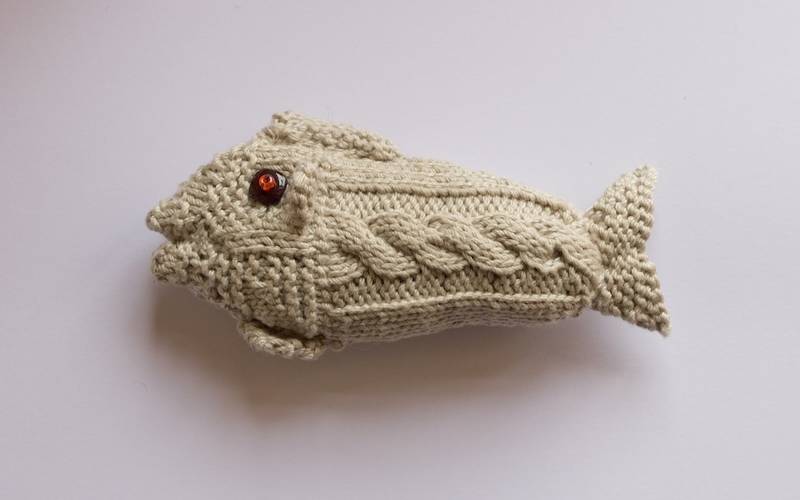
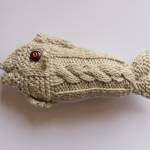
Dh’iarr am muir a thadhal
—Gaelic for “the sea wants to be visited.”
The first time I ever heard the word “gansey,” I was looking at a tiny knitted fish smaller than my hand.
I was on tour in the UK playing bluegrass festivals and folk clubs. A fan of mine brought his wife to my show and she was knitting a tiny fish. Being naturally drawn to any kind of handcraft, I had to ask. This is when I learned about ganseys.
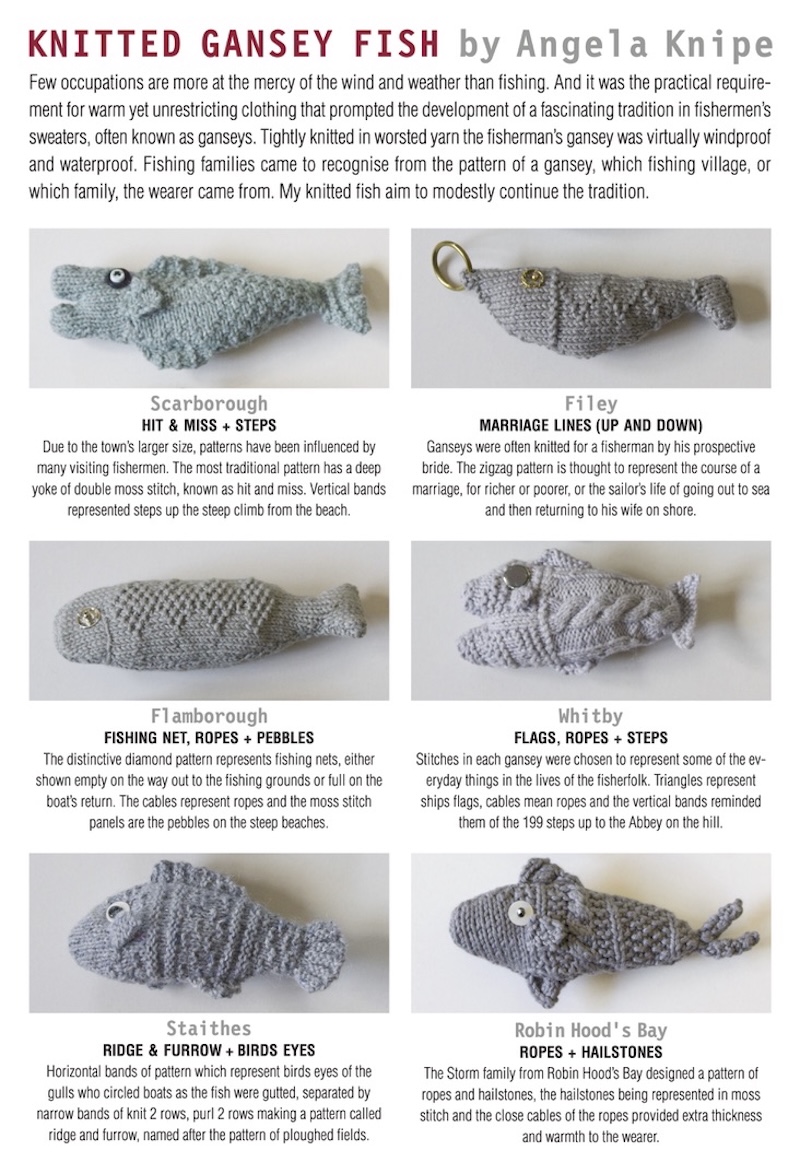
Angela Knipe’s gansey fish were so impossibly small and carried a whole language in their knitted scales. When I ran my finger across the texture of knit and purl stitches, I was reminded of the braille Bible that our minister used when she read scripture to us in Appalachia.
Braille is an apt comparison because the patterns in ganseys are a single color language of knit and purl stitches—a sea language spoken by communities who relied on fishermen and herring girls to bring in the haul and bring in the wages.
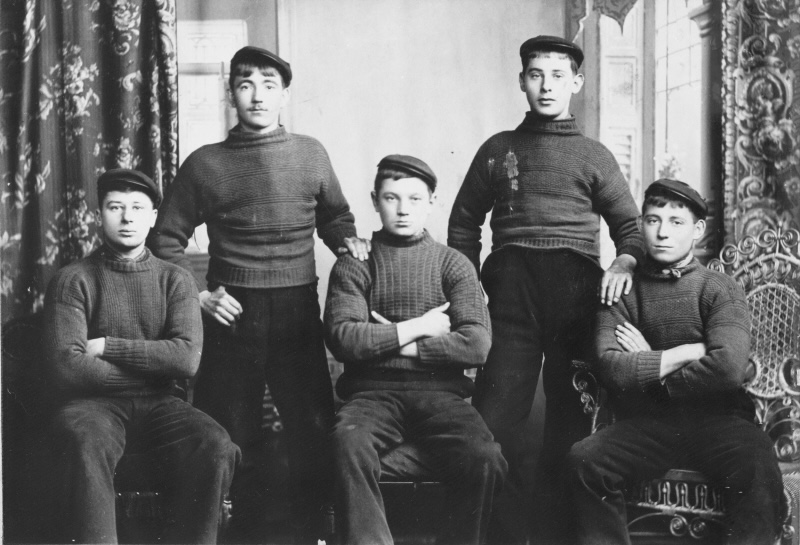
Studio Portrait of five men wearing ganseys at Cellardyke, Fife, Scotland. Original Image from Mr Johnson Smith.
A gansey at its most fundamental is workwear. It’s closely knitted, mostly in the round, on five needles in five-ply worsted wool. It’s seamless and has an underarm gusset.
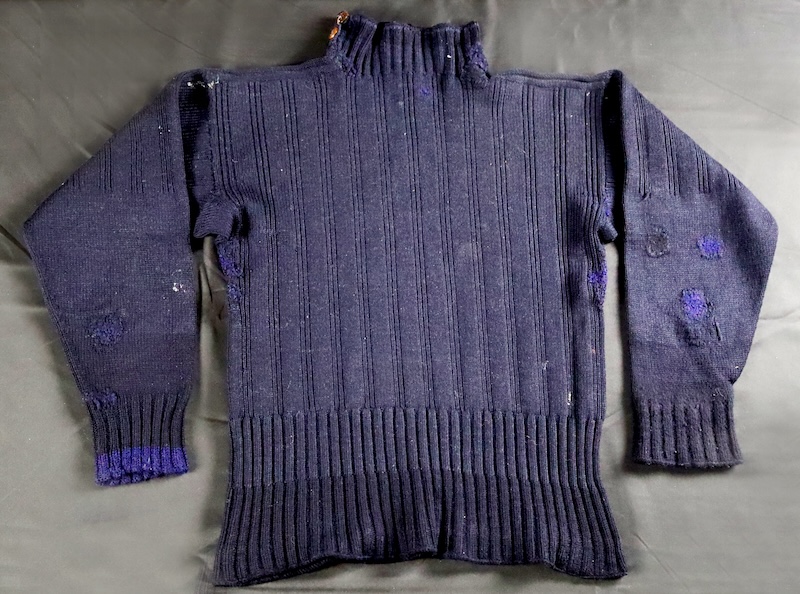
Knitted by Mary Muir Murray of Cellardyke for her husband Peter. 20th Century. Scottish National Gansey Collection.
The gansey is meant to hug the body to keep the fisherman warm and dry. That fabulous property of wool to repel water was put to the ultimate test aboard the cobles, the wind-powered fishing boats.
The welt, neck and cuffs were knitted snugly to keep out cold and water and the tightly knitted, somewhat short, cuffs also reduced the risk of the gansey being caught on machinery or tangled in equipment.
The yoke and the upper arms of the gansey were patterned because in patterns comes bulk and, thus, warmth. The sleeves and often the waist were knitted in stockinette and rib so that they could be frogged back and re-knitted with ease if damaged.
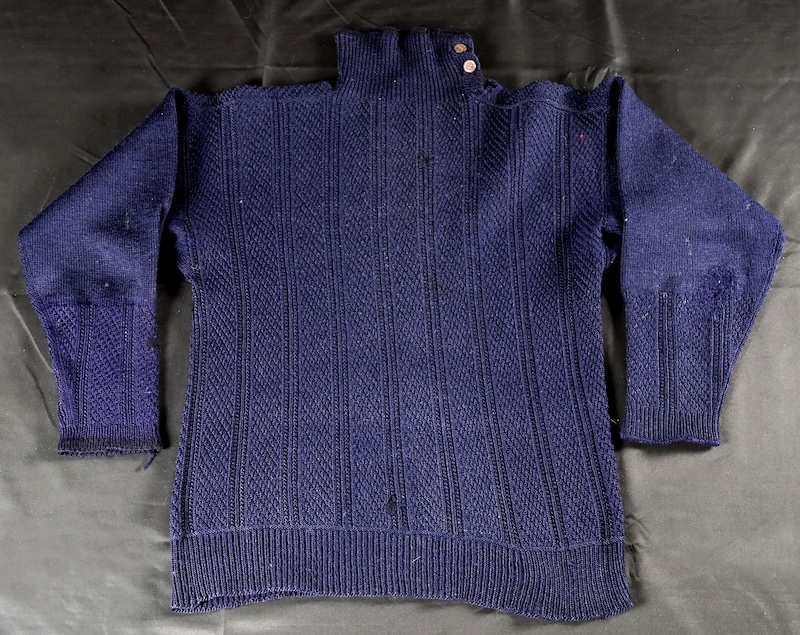
Navy blue hand-knitted gansey with small diamonds divided by cables. 20th Century. SCOTTISH NATIONAL GANSEY COLLECTION.
The origins of the gansey are lost to time. Is it inherited from the plainer jumpers associated with the Island of Guernsey in the English Channel? Is the gansey a descendant of the knitted, patterned silk garments imported into Britain from Italy in the 17th century?
We pattern detectives feel enticed by the fact that Old English “guern” comes from Norse for “garn” and it all means “yarn.” Should gansey researchers be looking to Scandinavia for answers?

What we do know is that fishermen wore them and worked in them from the early to mid-1800s until just after the second world war. Gansey patterns mimicked the ropes, nets, waves, weather, and even the bones of the herring the men sought and the women gutted and salted.
The gansey was the uniform of the herring fleet which boomed from 1850 until 1930. A number of things made herring so profitable at that time: the building of Pultney Harbor at Wick in Scotland, the “Scotch-cure” for salting fresh herring on the quayside, and James Patterson of Musselbourgh’s invention in 1850 of a loom that could weave strong cotton gill nets.
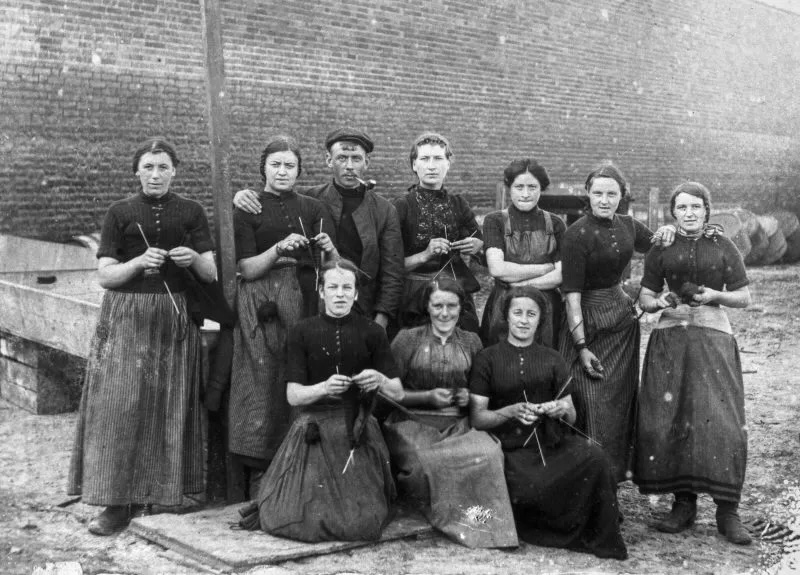
Herring girls knitting. Scottish Fisheries Museum.
This boom in herring fishing lead to mass migration for seasonal work from September to December with the Scottish herring-lassies traveling from as far as the outer Hebrides, down the east coast of Scotland, and picking up more “fisher girls” as they made their way along the east coast of England. Some traveled with their families in the fishing fleet.
Other women traveled as a group. They wore big boots, oil skin aprons to protect their skirts, short sleeves, and knitted shawls or hoods wrapped around their heads and shoulders to keep warm. Some wore ganseys, too, but rolled up at the arms so they could plunge their arms into the fish and into the barrels.
When they weren’t gutting and salting fish, the women knitted ganseys, and they exchanged patterns. Men also knit ganseys and both women and men repaired nets.

Portrait of Isabella Wood knitting or re-sleeving a gansey, c.1920-39. ORIGINAL IMAGE FROM ISABELLA SIMPSON, East Lothian, Scotland.
Some accounts still claim that if a fisherman was to drown at sea and wash ashore, folks could tell where he came from by the patterns in his gansey. To be fair, many of the patterns do have longstanding associations with ports. For instance, the Humber Star shows a star in the center of the breast. So, this was true for a time.
However, emerging research suggests that with as many as 6,000 herring girls and their knitting “wires” and wool on the move each season between Scotland and East Anglia, gansey patterns would have been widely disseminated throughout the fishing community and amongst knitters based at the ports. Over the years, knitting herring-lassies would certainly have been tempted more than once to trade their Filey diamond for the lush cables of Robin Hood’s Bay or their herringbone for a Tree of Life.
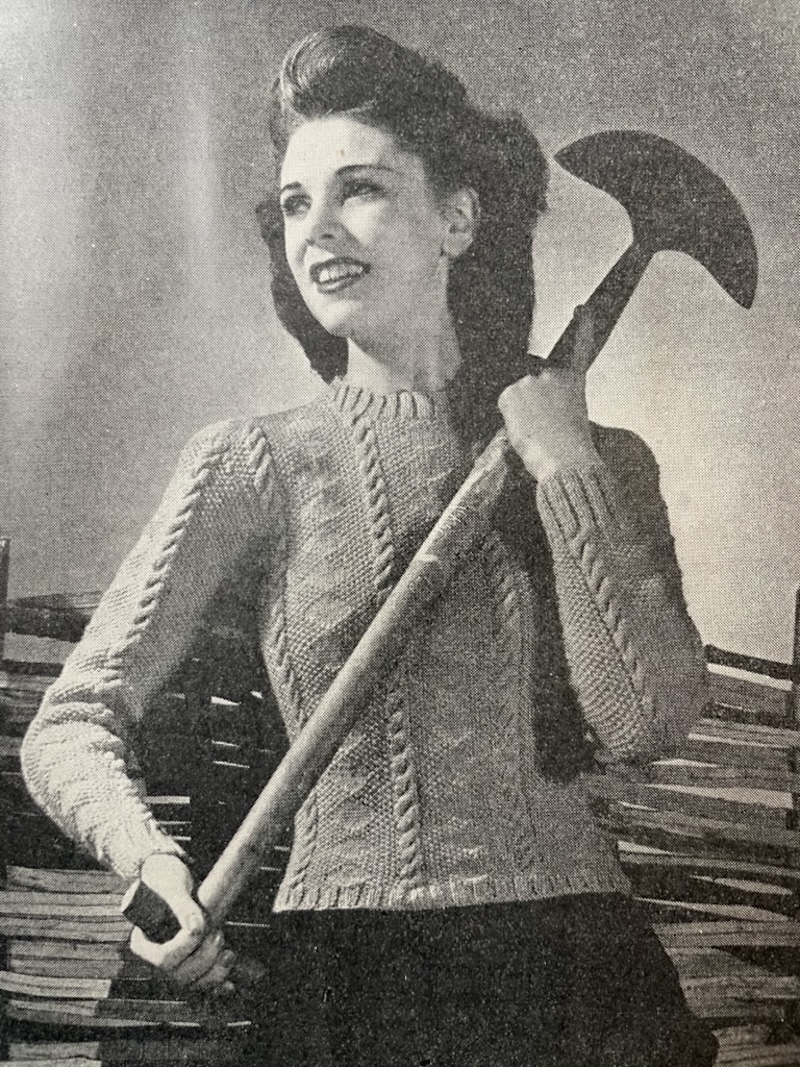
gansey patterns entered mainstream fashion just as the fishing boom ended. Here’s a pattern from the 1944 Complete Home Knitting Illustrated published in London by Odhams. The sweater has the diamond pattern symbolizing the fishing nets and the cable symbolizing ropes. The surrounding raised stitches represent pebbles—all part of the Flamborough gansey!
Notes:
If you’re looking for inspiration to knit your own gansey, visit Knitting the Herring and Following the Fish.
You can actually see film of the herring-lassies at Pathe films.
Header image: A Whitby gansey fish knitted by artist Angela Knipe. I’m pleased to say that Angela is knitting through her beloved, handwritten fish charts for me with an aim to release digital patterns in the coming year. Now in her eighties, Angela is delighted to find new fans of her fish!
You can hear my original fairytale song honoring the herring girls here. The title “Silver Darling” references the herring who were called “silver darlings” by the fishing community.


The East Neuk Knit Fest takes place 29-30 November and one of its themes is Scottish Fishermen’s Ganseys https://www.eastneukknit.com/. You can find the pattern to knit a gansey or lace herring here https://scottishgansey.org.uk/news-and-events/how-to/
Thank you, Alison!!!
What an amazing article! Incredible research . . . many thanks.
and
Now I know . . . I will knit my cat some fishes with a sachet of cat-nip inside.
I will start right away!
This is very interesting. I always enjoy your articles! I would definitely knit some small gansey fish and make purse charms!
Such an interesting article.p, thank you. I believe there are several ganseys in the museums on the Yorkshire coast.
I look forward to seeing the digital fish patterns.
Fascinating! Thank you Jeni for sharing this information. While studying the photos it is hard not to notice how young some of these people were and what challenging lives they led.
Jeni, what a wonderful article! I hope the Gansey Fish book comes to fruition. What a wonderful tradition and somewhat less daunting than an entire garment. In my mind’s eye I’m seeing a tree decorated with a variety of Gansey Fish swimming among fairy lights with sea shanties playing in the background!
Fascinating article with lots of links to further explore gansey history. I have a gansey that is about 40 years old. It is my “raking leaves in the fall” sweater, but I never appreciated its origins.
Thanks Alison for the pattern links. And I look forward to knitting a school of Angela Knipe’s herring.
So interesting Jeni! But what a hard life! I know some kitties that might enjoy a little catnip fish, though:). Thanks for the pattern, the article and the videos.
Hi –
A very entertaining article. I once read that not only were drowned sailors identified by the pattern of their ganseys but some knitters incorporated the Initials of the wearer into the patterning.
While waiting for Angela’s wee fish, there’s this free pattern from the Crafting History project at the Time and Tide Museum of Great Yarmouth Life:
https://www.ravelry.com/patterns/library/gansey-herring
My emotional support chicken needs a Gansey fish to keep it company.
I worry for the safety of the fish….
❤️
Very interesting article! And i *might* (maybe) be able to finish a gansey fish, so look forward to hearing about patterns!
Thank you Allison for another great article. So interesting. What a hard life. I’m watching my girlfriend’s cats over the holidays so I may try to knit a fish for them. She has some catnip to put in toys.
Fabulous article. Love the history and details, especially the photos. Will also be looking for patterns of the fish. They are amazing. The Norwegians call sweaters “genser” – could that be the origins of “gansey” ? Those vikings got around.
Thank you! I enjoyed your article.
I recently found a pattern book for these sweaters at a thrift store.
The patters are intriguing.
What a wonderful article on a beloved sweater!!! And I LOVE the fish!!!! What an incredible way to display the patterns and keep them alive. I would love to be able to purchase them when they come available. Thank you for this article.
Terrific deep dive as always Jeni, and very timely… I just began season five of Shetland last night and now this morning I understand a subtle plot point that I missed. The bar Jimmy Perez is investigating is called Silver Darlings. I will say, no more lest someone be as far behind in that series as I, but I can’t wait for my husband to wake up so I can tell him and have him read your article!
FWIW, the English children’s writer Monica Edwards, in her series set on Romney Marsh, which is set post WW2 but based on her childhood between the wars, has the local fisherman knitting their own ganseys, spelled guernseys. Also socks, with references to turning heels, and editorial comment from the author that knitting was not considered a “sissy” occupation.
In one of the later books when it’s becoming more difficult to make a living from the sea, the vicar sets up knitting machines to knit the plain parts so the villagers could produce enough to sell.
It is always fascinating to read your articles. Your research teaches us so much. And lots of great links to explore. This will keep me busy all day. Thanks!
I love everything about this!! And your music!!! I can’t wait to knit up a whole school of fish. Thank you so much for sharing. I love all of your posts, please keep them coming.
Wonderful article and research. Thank you!
This was an interesting article. Full of great information about Ganseys that I hadn’t heard before. The music gave it even more depth.
Here in Alaska we’re deep into ganseys, led by the yarn shop in the fishing town of Cordova. https://thenetloftak.com/pages/cordova-gansey-project
Also, for another gansey fish, see @wee_ewe_knits flatfish patterns: https://www.ravelry.com/patterns/library/gansey-flatfish
What a great article on the gansey sweaters and the history behind them. I learned so much from it. Those were hardy men and women!!! Love the small knitted fish with their local pattern! Thanks for sharing❤️
Thank you for this. I’m a little obsessed with the fisherman’s gansey, and have several of the books listed. I think ganseys are in my bloodline, and I have made some, but plan on making more.
Fascinating! Interesting to hear that both men and women knitted ganseys. My son knits, and I’m always looking to recruit other knitting men.
Brilliant article – and so inspiring! Only recently started knitting again after many, many years and getting ‘hooked’ (pardon the pun!) on any information I can gather about Ganseys and this article seemed to cover it all. Well done and thank you – will be looking for any more snippets that you have to offer! Wendy
Nets, ropes and pebbles. You’ve made my day. Thanks. I’m on this. #inspiration
Another well researched article! I have made a few ganseys, but I can’t wait for the fish! I also got a chuckle out of the last photo where the model is brandishing a sod cutter!
A flatfish addition to our knitted fish library:
https://www.ravelry.com/patterns/library/gansey-flatfish